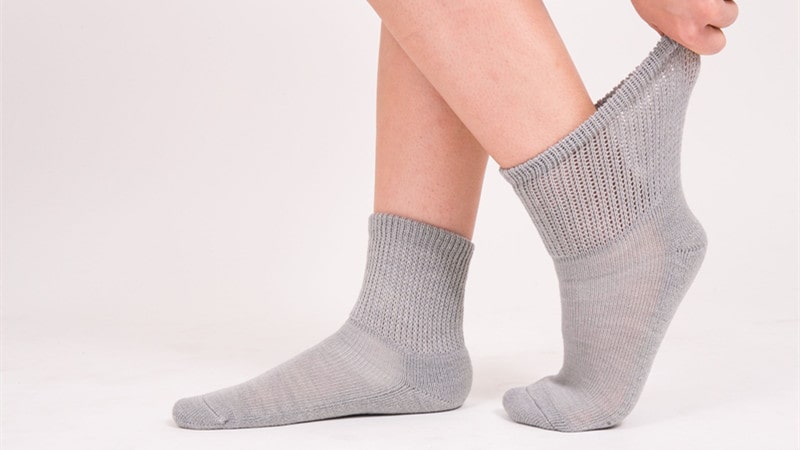Diabetes is a chronic disease that affects millions of people worldwide. One of the many complications associated with diabetes is neuropathy, which can lead to foot problems such as ulcers, infections, and even amputations.
To prevent these complications, diabetic patients are often advised to wear special socks designed to improve foot health. These socks, commonly known as diabetic socks, are made with materials that help regulate blood flow, reduce pressure, and prevent moisture buildup.
But what exactly is a diabetic sock, and how do they help? Here’s an overview of the significant details surrounding these specialized socks.
What Are Diabetic Socks?
Diabetic Socks are specially designed socks that protect your feet from injuries, infections, and poor circulation. They are usually made of soft, breathable, moisture-wicking materials that keep your feet dry and comfortable. They also have seamless toes, non-binding tops, and extra cushioning to prevent friction, pressure, and irritation.
These socks are not the same as compression socks, which are tight-fitting socks that apply pressure to your legs and feet to improve blood flow. Compression socks can benefit some people with diabetes, but they are not suitable for everyone. Diabetic socks are more gentle and flexible and do not restrict blood flow.
Why Do People With Diabetes Need Diabetic Socks?
People with diabetes need diabetic socks because they are more prone to foot problems than people without diabetes. Diabetes can cause nerve damage (neuropathy) and blood vessel damage (peripheral arterial disease) in the feet, which can lead to:
Loss of sensation
Diabetes can damage the nerves in the feet, which can lead to a condition called neuropathy. This means that people with diabetes might not sense pain as well if they hurt their feet. Additionally, they might not be aware if their feet are exposed to extreme temperatures, such as cold or hot surfaces.
Poor Blood Flow
In addition to nerve damage, diabetes can also impact the blood vessels that supply the feet. When blood flow is insufficient, it can hinder the body’s natural healing process. This is particularly concerning because even minor injuries, like cuts or blisters, might take much longer to heal.
Foot Sores
Diabetes-related foot problems can lead to open sores or ulcers caused by nerve damage and poor blood circulation. Treating these ulcers is difficult and may require specialized medical attention. If the sores become infected, serious complications can arise, potentially spreading to other body parts.
Foot deformities
People with diabetes might experience changes in the shape of their feet over time. Conditions like bunions or hammertoes can develop where the toes are positioned abnormally. In more severe cases, a condition known as Charcot foot might occur.
Amputation
In the most severe cases, the foot problems that arise from diabetes might necessitate amputation, which involves surgically removing part or all of the foot or leg. This is a drastic measure taken to prevent the spread of infections and to safeguard a person’s overall health.
Diabetic socks can help prevent these complications by keeping your feet healthy and comfortable. They can reduce the risk of blisters, cuts, scrapes, corns, calluses, ingrown toenails, fungal infections, and other foot problems that can lead to more serious issues.
Types of Diabetic Socks
There are different types of diabetic socks available in the market, depending on your needs and preferences. Some of the common types are:
- Crew Socks – Popular and versatile, crew socks cover ankles and lower calves, offering warmth and protection.
- Low-Cut Socks – Also called ankle or no-show socks cover feet and ankles, ideal for low-cut shoes or sneakers.
- Dress Socks – Thin and sleek, these socks complement formal footwear, though they may have less padding.
- Sports Socks – Designed for active wear, sports socks are thick and sturdy with added heel and toe cushioning.
- Slipper Socks – Warm and cozy for indoor or nighttime use, they often have slip-resistant soles.
You can choose the type of diabetic sock that suits your lifestyle, activity level, footwear, and personal taste. You can also choose different colors, patterns, sizes, and lengths.
How to Choose Diabetic Socks?
When choosing diabetic socks, you should consider the following factors:
| Aspect | Recommendations |
| Size | Choose diabetic socks that fit well, not too tight or loose. Refer to the size chart by the manufacturer and measure your feet and legs before purchasing. They should stay in place without bunching up or sliding down. |
| Material | Opt for soft, breathable, moisture-wicking materials like acrylic, bamboo, wool, or cotton blends. Avoid synthetic materials such as nylon or polyester that can trap heat and moisture. |
| Style | Select the style that suits you, such as crew, ankle, knee-high, or over-the-calf. Pick colors and patterns you like. Some experts suggest white or light-colored socks spot any bleeding or drainage. |
| Features | Look for seamless toes, non-binding tops, and extra cushioning to prevent friction, pressure, and irritation. Some diabetic socks may include antimicrobial or antibacterial properties to prevent odor and infection. |
How to Care for Diabetic Socks?
To get the most out of your diabetic socks, you should follow these tips:
- Wash your diabetic socks after each use with mild detergent and cool water. On a gentle cycle, you can wash them by hand or in a washing machine. Use a mesh bag to protect them from getting snagged or stretched.
- Dry your diabetic socks on low heat or air dry them. Avoid using a dryer or ironing them, as high heat can damage the fibers and reduce their effectiveness.
- Replace your diabetic socks every 3 to 6 months or when they show signs of wear and tear, such as holes, tears, or thinning. Worn-out diabetic socks can lose shape and function and increase the risk of foot problems.
Conclusion
Diabetic socks are an important aspect of foot care for individuals with diabetes. They are designed to prevent complications and provide comfort and protection to the feet. Diabetic socks are made of high-quality materials that are gentle on the skin, reduce pressure on the feet, and promote circulation.
These socks are available in various styles and sizes to suit individual needs. It is crucial to choose the right pair of diabetic socks and wear them regularly to maintain good foot health and prevent serious complications. Individuals with diabetes should consult their healthcare provider to determine the best socks for their specific needs.




